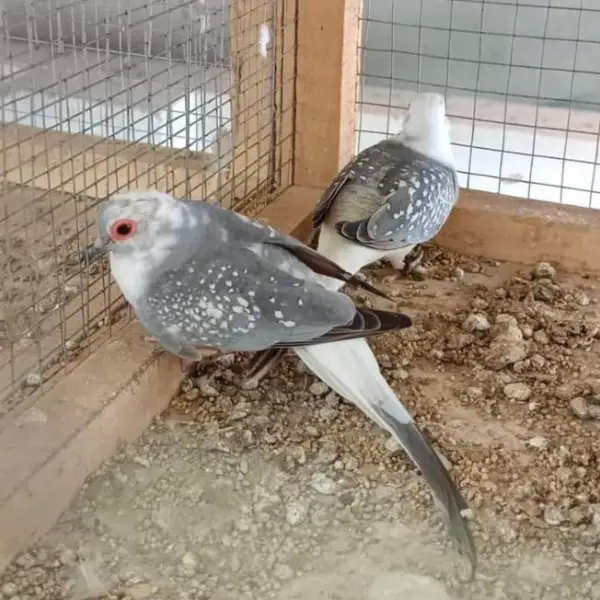Free shipping order over 20,000
Fawn Java Sparrow
₨ 12,000 Original price was: ₨ 12,000.₨ 7,000Current price is: ₨ 7,000.
-
-
-
- Scientific Name: Padda oryzivora
- Size: Approximately 13-15 cm (5.1-5.9 inches) in length.
- Color: The Fawn Java Sparrow is a color variation of the Java Sparrow. It has a soft, fawn or beige plumage covering most of its body. The face is lighter, with a distinct white ring around the eyes and a pale pinkish beak. The underparts are slightly lighter, while the wings and back may show a richer fawn color.
- Beak: Large, strong, and pinkish in color, suited for cracking seeds.
- Eyes: Dark, surrounded by a white eye-ring, which contrasts with the fawn plumage.
- Legs and Feet: Pale pink or flesh-colored.
-
-
SKU: REF. LA-5766-9-1-1-1-1-1-1-1-1-1-1-1-1-1-1-1-1-1-1-1
Categories: JAWA FINCH, Uncategorized
Tag: jawa finch
Share
Share on facebook
Share on email
Important Keys:
Habitat
- Distribution: The Java Sparrow is native to Indonesia, particularly the islands of Java, Bali, and Bawean. The Fawn Java Sparrow, as a domesticated color variant, is primarily found in captivity worldwide.
- Environment: In the wild, Java Sparrows prefer open grasslands, cultivated fields, and areas near human habitation. In captivity, they are often kept in aviaries and cages.
Diet
- Primary Food: Seeds, particularly those from grasses and cultivated crops like rice, are the main component of their diet.
- Supplementary Food: Fruits, vegetables, and occasional insects are also part of their diet, especially in captivity where variety is provided.
- Feeding Behavior: They forage on the ground, searching for seeds, and in captivity, they will eat from feeders or directly from the substrate.
Breeding
- Breeding Season: In the wild, breeding typically occurs during the rainy season, but in captivity, they can breed year-round if conditions are right.
- Nest Location: Nests are built in trees, shrubs, or nest boxes provided in captivity. The nest is constructed from grasses, feathers, and other soft materials, forming a dome-shaped structure.
- Egg Quantity: Clutches usually consist of 4-6 eggs.
- Incubation Period: About 13-15 days.
- Fledging: Chicks fledge around 21-28 days after hatching.
Lifespan
- In the Wild: Typically around 5-7 years.
- In Captivity: Can live up to 8-10 years or more with proper care.
Behavior
- Social Structure: Fawn Java Sparrows are social birds, often seen in pairs or small flocks. In captivity, they thrive in the company of their own kind or other finches.
- Vocalization: Their calls are soft, melodious chirps and whistles, often heard in communication and courtship.
![]()
Be the first to review “Fawn Java Sparrow” Cancel reply
Related Products
-
-70%
Zebra Finch
₨ 5,000Original price was: ₨ 5,000.₨ 1,500Current price is: ₨ 1,500. -
-22%
Strawberry Finch
₨ 4,500Original price was: ₨ 4,500.₨ 3,500Current price is: ₨ 3,500. -
-11%
Albino Shaft Tail
₨ 22,500Original price was: ₨ 22,500.₨ 20,000Current price is: ₨ 20,000. -
-20%
Owl Finch
₨ 20,000Original price was: ₨ 20,000.₨ 16,000Current price is: ₨ 16,000. -
-20%
Lotino Gouldian Finch
₨ 15,000Original price was: ₨ 15,000.₨ 12,000Current price is: ₨ 12,000. -
-20%
Common Gouldian Finch
₨ 12,500Original price was: ₨ 12,500.₨ 10,000Current price is: ₨ 10,000. -
-13%
Gray Diamond Firetail Finch
₨ 23,000Original price was: ₨ 23,000.₨ 20,000Current price is: ₨ 20,000. -
-42%
Silver Pied Dove
₨ 12,000Original price was: ₨ 12,000.₨ 7,000Current price is: ₨ 7,000.
Sign Up for Exclusive Birds Care Tips and Offers from Phool Panchi
Company links
Category
Contact
© 2024 Phool Panchi | Developed By v3Studio















Reviews
There are no reviews yet.